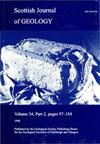拉克斯福特构造演化的区域解释及其对刘易斯地体模式的启示
IF 1.3
4区 地球科学
Q4 GEOLOGY
引用次数: 1
摘要
刘易斯杂岩的晚古元古代(拉克斯福特)构造和变质史可以用几个主要的运动学变化来解释。在约1.9 Ga时,邻近的Rae、北大西洋(NAC)、Kola和Karelia太古宙克拉通相互隔离,在其边缘处于俯冲和增生的活跃状态。在约1.85 Ga的“早拉克斯弗德”时期,当时属于纳格苏木-祁底造山带的刘易斯板块经历了北西-西向的构造运动,这可能是由Rae克拉通与NAC的东西辐合引起的,可能是由与波罗的海的碰撞引起的。约1.7 Ga,在“晚拉克斯福特”时期,南北辐合的重大变化产生了NW-SE向褶皱和NW-SE向右旋剪切带的组合。在c. 1.6 Ga之后,运动系统再次发生变化。后两种变化可能归因于努纳超大陆组装过程中更多大型克拉通的对接。刘易斯地块模式可以用Rae和NAC两个主要克拉通之间的相对运动来解释。夹在它们之间的是第三个,它的物质部分来自于一个或多个位于海洋地壳中的岩浆弧。亚辛地体可能是上板块NAC的孤立残余物,而大部分剩余的刘易斯露头可能由变质的Rae物质组成。本文章由计算机程序翻译,如有差异,请以英文原文为准。
A regional explanation for Laxfordian tectonic evolution and its implications for the Lewisian terrane model
The later Paleoproterozoic (Laxfordian) structural and metamorphic history of the Lewisian Complex can be explained by several major kinematic changes. At c. 1.9 Ga, the neighbouring Archean cratons of Rae, North Atlantic (NAC), Kola and Karelia were isolated from each other and subduction and accretion were active at their margins. At c. 1.85 Ga, during the ‘Early Laxfordian’, the Lewisian, then part of the Nagssugtoqidian orogenic belt, experienced NW–SE-directed tectonic movements attributed to east–west convergence between the Rae Craton and the NAC, probably prompted by collision with Baltica. At c. 1.7 Ga, during the ‘Late Laxfordian’, a major change to north–south convergence produced a combination of NW–SE-trending folds and NW–SE dextral shear zones. The kinematic system changed again after c. 1.6 Ga. The latter two changes may be attributable to the docking of further large cratons as the Nuna supercontinent was assembled. The Lewisian terrane model can be interpreted in terms of the relative movements between two major cratons, Rae and NAC. Sandwiched between them was a third, composed of material partly derived from a juvenile magmatic arc or arcs situated in oceanic crust. The Assynt terrane may be an isolated remnant of the upper-plate NAC, whereas most of the remaining Lewisian outcrop may consist of modified Rae material.
求助全文
通过发布文献求助,成功后即可免费获取论文全文。
去求助
来源期刊

Scottish Journal of Geology
地学-地质学
CiteScore
1.70
自引率
0.00%
发文量
10
审稿时长
>12 weeks
期刊介绍:
Although published only since 1965, the Scottish Journal of Geology has a long pedigree. It is the joint publication of the Geological Society of Glasgow and the Edinburgh Geological Society, which prior to 1965 published separate Transactions: from 1860 in the case of Glasgow and 1863 for Edinburgh.
Traditionally, the Journal has acted as the focus for papers on all aspects of Scottish geology and its contiguous areas, including the surrounding seas. The publication policy has always been outward looking, with the Editors encouraging review papers and papers on broader aspects of the Earth sciences that cannot be discussed solely in terms of Scottish geology.
The diverse geology of Scotland continues to provide an important natural laboratory for the study of earth sciences; many seminal studies in geology have been carried out on Scottish rocks, and over the years the results of much of this work had been published in the Journal and its predecessors.
The Journal fully deserves its high reputation worldwide and intends to maintain its status in the front rank of publications in the Earth sciences.
 求助内容:
求助内容: 应助结果提醒方式:
应助结果提醒方式:


